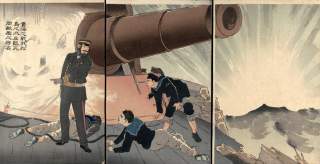In 1895, China and Japan Went to War. Nothing Has Been the Same Since.
Asia has never been the same since.
AT THE TIME the Treaty of Shimonoseki was signed, the question of which islets “appertained or belonged” to Taiwan did not generate particular controversy or merit great attention. Having annexed the Ryukyu Islands, which include Okinawa, in 1879, Japan effectively controlled the entire northern portion of the “first island chain”—as the Chinese refer to the string of archipelagos closest to their own shores—and the legal distinctions between particular outcroppings had little practical significance.
Today, however, what should have remained an academic question has become a pressing concern, as tensions between China and Japan spiral skywards thanks to a dispute over a tiny group of islands roughly equidistant from Taiwan and the closest of Japan’s undisputed possessions. (Taipei claims the islands as well – with some there doing so on behalf of the Republic of China, and others for Taiwan itself.)
Under the terms of the Treaty of San Francisco, which formally ended the Pacific War, Japan agreed to return that which it had taken from China at Shimonoseki: Taiwan and "all islands appertaining or belonging to [it]." Yet Tokyo argues that the Senkakus, as it calls the disputed islets, were not among the spoils of the Sino-Japanese War, insofar as they came under Japanese control several months before the peace treaty was signed in April 1895, and were previously terra nullius rather than a part of Taiwan and a possession of the Qing.
Not surprisingly, few Chinese are willing to recognize this fine distinction between territory which was “stolen” by treaty and that which Tokyo peacefully incorporated into Okinawa Prefecture four months earlier. Either way, the Diaoyus, as China calls the islands, were taken by the Japanese in the midst of a war that not only marked the end of a millennia of Chinese regional dominance, but was a precursor to the far bloodier conflict that erupted in the 1930s. While Beijing cites maps which purportedly show the deserted islands to have been “Chinese” as early as the sixteenth century, the impetus for contesting their ownership comes not from faded charts, but rather from a desire to reclaim the status that China lost the same year the islands came under Japanese control.
FROM AN American perspective, the significance of this short intra-Asian struggle for regional supremacy could not have been immediately obvious. Although U.S. troops helped put down the Boxer Rebellion in 1901, and Theodore Roosevelt won a Nobel Prize for his role in negotiating an end to the Russo-Japanese War several years later, Americans still lived in a world in which a foreign rivalry over the Balkans mattered far more than one over Korea or Taiwan.
Looking back on the twentieth century, however, it becomes clear that the First Sino-Japanese War was a landmark in American history as well as that of East Asia. If not the proximate cause of the events which drew the United States deeper into regional power politics–the Pacific War; the fight over a divided Korea; the ideational chasm between Beijing and Taipei–it is nonetheless a signal event in understanding each one, the wave which determined the region’s turbulent course.
Indeed, although few in Washington have heard of the Treaty of Shimonoseki, the United States is even now deeply enmeshed in a dispute which derives directly from the ambiguity of its terms. Having played a pivotal role in allowing Japan to retain control of the Senkaku Islands after the Pacific War, the United States today maintains neutrality on the basic question of sovereignty, but has indicated that an act of belligerence by China would nevertheless trigger the American security commitment to Japan.
With the recent announcement of a new air defense identification zone (ADIZ) covering the islands, Beijing has heightened the stakes in this showdown and increased the risk–already elevated by the presence of drones–of a clash in the air. Even as both China and Japan have been radically transformed since locking horns over Korea in 1894, this latest chapter in the long tussle for regional primacy is a vivid illustration of the degree to which the terms of their contest are defined by their past.
As we watch this dangerous drama unfold, what is the significance of the First Sino-Japanese War? As Zhou Enlai is said to have responded when asked about the French Revolution: “It’s too soon to tell.”

